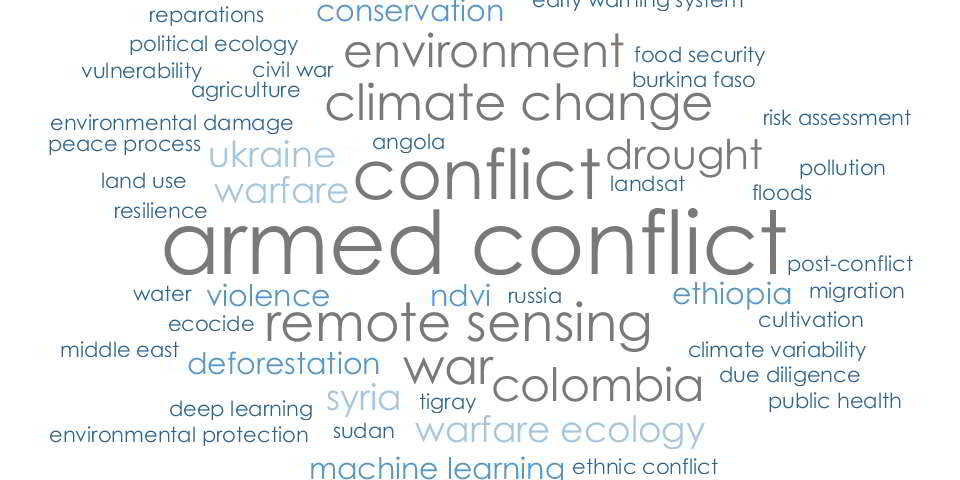CEAN’s members are encouraging and benefitting from the growing research attention on the environmental dimensions of armed conflicts.

The Conflict and Environment Academic Network (CEAN) has celebrated its first anniversary with a full day of talks and posters at the 2024 American Geophysical Union Fall Meeting. In this post, Rob Watson charts CEAN’s progress over the last 12 months and outlines the network’s aims for the following year.
Introduction
When we launched CEAN the core motivation was to catalyse and strengthen interdisciplinary collaboration between those monitoring and researching environmental change in conflict settings. Since then, we have co-convened a session at the European Geoscience Union General Assembly in Vienna in April, and are currently participating in the American Geophysical Union Fall Meeting in Washington DC, where members are presenting nine talks and 13 posters. The existence of dedicated sessions at major international conferences, as opposed to work being uncomfortably shoehorned into more general environmental sessions, reflects the increasing attention being given to the field, as does the growth of CEAN: we now have 163 members from more than 30 countries.
A bibliography of academic publications from 2024
We have compiled a bibliography of publications for 2024 to examine the nature of relevant work being done at present, and to help understand where there are opportunities for growth. We used a combination of databases — Web of Science, Directory of Open Access Journals and Google Scholar — and both programmatic and manual data searches. We are currently reviewing the data for previous years, and aim to make the full list available early next year.
We identified 119 articles published in 2024 that consider the many environmental dimensions of armed conflicts. The vast majority of these (114) are in English, with the remainder in Spanish and Portuguese. We are certain that there were articles published in other languages, such as Ukrainian and Arabic, which we are yet to become aware of. We would love to expand the list to include these — along with additional articles in English that we have surely missed as well — so if you have authored or read any articles that you think should feature but are not included then please let us know.
The publications in which these pieces appear are highly diverse, with 95 different journals, books and theses hosting the included work. In particular, two special issues produced 12 articles in 2024 — and several more the previous year — that CEAN members contributed to: ‘Legacy of Warfare on the World’s Forests’ in Trees, Forests and People and ‘Land Cover and Land Use Change in Conflicted Societies’ in Science of Remote Sensing. The articles covered a multitude of topics and study areas, from detecting Vietnam War era bomb craters using declassified US spy satellite imagery, to surveying changes in logging practices in Syria, to mapping forest disturbance in the Andean Paramo, to evaluating cropland disturbance in Tigray. The variety of research within these two special issues alone should provide significant food for thought among all of us working in this area.

What next for CEAN?
CEAN’s primary objective is to help push conflict and the environment up research and thus policy agendas. In spite of CEAN’s success in connecting researchers across disciplines, a qualitative examination of our 2024 bibliography indicates that interdisciplinary research is still not the norm when it comes to studying armed conflict and the environment. Continuing to bridge these divides and encourage more interdisciplinary work will therefore be a major focus in future.
Furthermore, increasing access to funding for this research, especially for those from conflict-affected states, is a precondition to improving representation within research spaces of both the discipline generally, and of those communities affected by armed conflict. If you have ideas for how CEAN could fund this area of work, or if you have funds that you could contribute towards making it a greater focus of what we do — to date, all the work done by CEOBS to build CEAN has been unfunded — we would love to hear from you!
We will continue to host quarterly online meetings where we spotlight a researcher with a 15-20 minute presentation. This is typically followed by discussion and development of the Network’s objectives and strategy. All members are very welcome and are encouraged to attend and contribute.
The next CEAN meeting will be on 29 January at 09:00 UTC,1 with further details to be sent out to members in January. If you would like to become a member, complete this application form.
You can view the 2024 bibliography of articles here, preceding years will follow soon, and please contact us if you have any questions or suggestions for further articles to include.
Rob Watson coordinates CEAN’s work for CEOBS.





